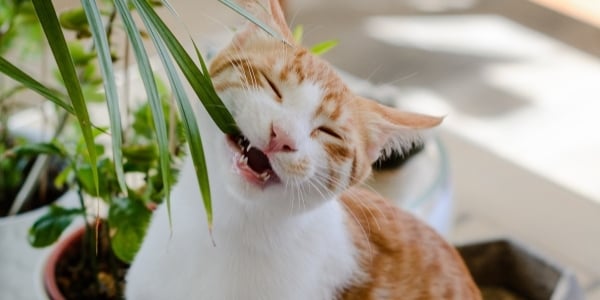 It's important to know what plants in your home or yard are toxic to cats.
It's important to know what plants in your home or yard are toxic to cats.
That's why we have put together this list of popular plants found in many homes. If you have any of these houseplants, don't be hard on yourself — you're not alone.
Either replace your toxic plant with a safer plant or make sure the plant is well out of reach of your cat.
Some plants, like lilies, are so dangerous that if the pollen blows off the flowers from the breeze coming through an open window, lands on your cat, and they groom it off, they could be in very serious trouble. Read on for which plants to avoid.
Skip to Specific Plant Toxicity
Avoid Plants Poisonous to Your Cat
Understandably, cat owners have good reason to be concerned about the toxicity of some household plants. According to ASPCA Animal Poison Control, in 2020 exposure to bouquets, and indoor and outdoor plants moved up two places on their top toxins lists to make it to one of the top 5 common causes of people calling their poison control center, resulting in more than 9,000 more calls than the year prior.
Toxicity and Symptoms Are Dependent on the Plant
There is a long list of poisonous plants that you should not have in your home if you have a cat. We've listed some of the more common ones below.
The degree of toxicity and symptoms your cat may exhibit depends on the specific plant and the amount, as well as the part(s) of the plant your cat has potentially consumed, in addition to your cat's size, any existing medical conditions, medications they may be taking, and a host of other factors.
It is vital that you contact your veterinarian, Animal ER, or an animal-specific poison control hotline immediately if you believe your cat has nibbled on or eaten any amount of a toxic plant or flower.
Popular Household Plants That Are Toxic to Cats
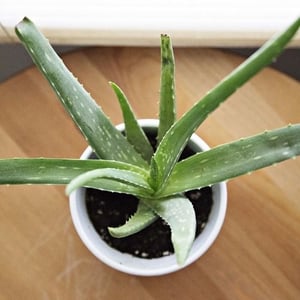
Aloe
Although aloe vera is known for its health benefits for people, it contains saponins (specifically anthraquinone glycosides), and this compound is toxic to cats. Anthraquinone glycosides act similar to laxatives.
Signs of Aloe Toxicity in Cats
Toxicity in cats is typically mild to moderate, resulting in diarrhea and vomiting, as well as stomach discomfort.
Onset of Symptoms
Signs usually occur within a few hours of ingestion – after the gastrointestinal bacteria has had time to metabolize the toxin.
Amaryllis
The Amaryllis is part of the Liliaceae family, but unlike ‘true lilies’ (listed below) they do not have the same toxic principal, but rather their toxin is similar to the daffodil and alkaloid in nature.
All parts of the Amaryllis plant contain a phenanthridine alkaloid, which if ingested, may cause vomiting, a drop in blood pressure, and shallow or difficult breathing.
Though all parts of the plant are toxic, the bulb, which is often exposed in these plants, is the most dangerous part for cats, as they contain raphide oxalate crystals which are needle-shaped crystals, whose purpose in a plant's bulb is to specifically repel animals. And, if ingested, will cause oral pain, irritation, and discomfort, resulting in excessive drooling, pawing at the mouth/face, occasional vomiting, and even occasional difficulty breathing.
Signs of Amaryllis Toxicity in Cats
Vomiting, change in energy level and/or anti-social behavior, diarrhea, abdominal pain and tenderness, excessive drooling, lack of appetite, shaking, and tremors.
Onset of Symptoms
Signs typically develop immediately if a cat licks or chews on the bulb causing oral irritation. The remaining symptoms may take up to 2–4 hours after ingestion.
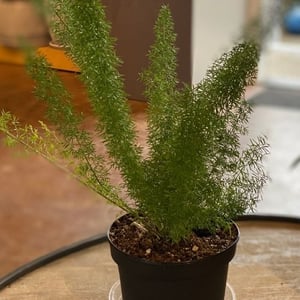
Asparagus Fern
Asparagus fern is commonly used in floral arrangements and as houseplants due to its fine foliage.
Signs of Asparagus Fern Toxicity in Cats
Their toxicity is relatively mild, however, with repeated exposure to the skin, allergic dermatitis may result. Additionally, ingestion of the berries may cause mild gastrointestinal upset such as vomiting, diarrhea, decreased appetite, and/or abdominal discomfort.
Onset of Symptoms
Repeated dermal exposure may take several weeks to months to appear on a cat's skin. Gastrointestinal signs after eating of the berries may occur within hours.
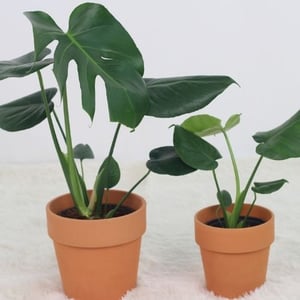
Ceriman (Hurricane Plant, Mexican Breadfruit, Cut-leaf, or Swiss Cheese Plant)
The Ceriman is one of the most popular household plants because of its tropical appearance.
However, due to the insoluble calcium oxalates that reside on the leaves and stems of this plant, this makes them moderately toxic to cats.
Signs of Ceriman Toxicity in Cats
Extreme mouth irritation can lead to swelling of the tongue, lips, and face. Symptoms include excessive drooling, pawing at the face and mouth, crying out in discomfort, occasional vomiting, and difficulty swallowing may be seen on occasion. There can be irritation to the skin if it comes in contact with the sap.
Onset of Symptoms
Signs typically develop immediately if a cat bites or chews on this plant causing oral irritation. Gastrointestinal signs may take up to 2–4 hours after ingestion.

Cyclamen
A common flowering plant that is often given as a gift, due to the beautiful flowers that typically blossom during the winter months. However, don't let their beauty fool you, as they are very toxic.
All parts of this plant (especially their parts below the soil) can be deadly to your cat. This is because cyclamens contain saponins, also referred to as triterpene glycosides.
All parts of the Cyclamen plant contain saponins, however, the tubers (the parts that are underground) contain the largest amount and therefore are the most toxic parts of this plant.
Signs of Cyclamen Toxicity in Cats
When any part of the plant is ingested, symptoms may be drooling, vomiting, and diarrhea. When cats ingest large amounts of this plant (especially the tubers or roots), these toxins can cause cardiac problems, such as arrhythmias (irregular rate and/or rhythm of the heart), seizures, and death.
Onset of Symptoms
Depending on the part of the plant, as well as how much of the plant is ingested, signs can occur immediately (particularly if the tubers are ingested) or up to several hours after ingestion.
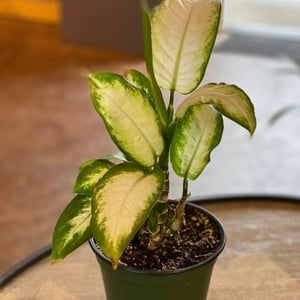
Dieffenbachia (Dumb Cane)
Found in many households, like the Hurricane Plant, this plant contains insoluble calcium oxalates making them toxic to cats. These crystals will cause intense irritation and burning to the lips and tongue, and gastrointestinal tract irritation if swallowed.
Signs of Dieffenbachia Toxicity in Cats
Extreme mouth irritation can lead to swelling of the tongue, lips, and face, including ulcers and blisters in the mouth. Common signs include excessive drooling, pawing at the face or mouth, decreased appetite, oral pain, vomiting, and less commonly difficulty swallowing.
Onset of Symptoms
Signs will develop immediately if a cat bites or chews on this plant causing oral irritation. Gastrointestinal signs may take up to 2–4 hours after ingestion.
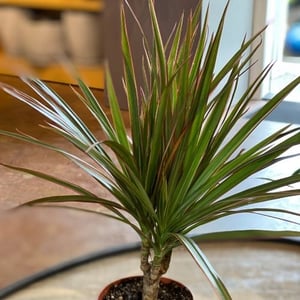
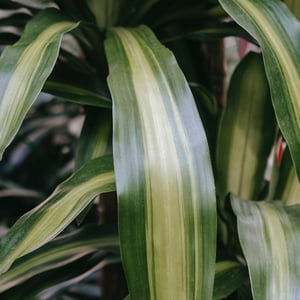
Dracaena (Corn Plant)
This common houseplant also contains the compound saponins (similar to Aloe and other plants on this list) and therefore can be toxic to your cat if ingested.
Because this plant comes in many varieties, we've provided two versions in the photos.
Signs of Dracaena Toxicity in Cats
Excessive drooling, mental dullness, change in energy level, lack of appetite, dilated pupils, and vomiting (occasionally with blood).
Onset of Symptoms
Symptoms may occur within hours of ingestion.
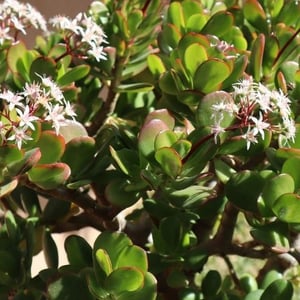
Jade
A common succulent plant found in households – the Jade plant (or Chinese Jade) is considered toxic to cats if ingested, however, the toxicity is considered mild and self-limiting (resolves without treatment).
Signs of Jade Toxicity in Cats
The most common symptoms are vomiting, lethargy, decreased appetite, and an uncoordinated gait (stumbling).
Onset of Symptoms
Signs may not be evident due to the mild toxicity, but if noticed may develop within 1–4 hours of ingestion.

Lilies
True lilies are possibly the most dangerous and life-threatening toxin known to cats. It must be noted that there are both benign and dangerous lily plants, and it’s important to know the difference.
The dangerous lilies refer to those of the Hemerocallis and Lilium species (true lilies), such as Easter lilies, Japanese show, Asiatic, stargazer, wood, red, western, tiger, and rubrum lilies. Daylilies are from the Hemerocallis genera and are also extremely harmful.
Whereas benign or less toxic lily varieties include Peruvian, peace, and calla lilies that aren’t responsible for causing the same life-threatening issues as the Lilium and Hemerocallis species. Instead, they contain oxalate crystals that cause minor symptoms, such as irritation to the tissues of the mouth, and oral cavity, which may result in some drooling.
However, with the Lilium and Hemerocallis sp., even the smallest of ingestions are potentially fatal.
Signs of Lily Toxicity in Cats
The smallest of ingestions, the Lilium and Hemerocallis sp., are potentially fatal and will likely result in severe, acute kidney failure. Symptoms may include increased thirst, trouble urinating, no urine production (anuria), vomiting, not eating, lethargy, weakness. Read more about lily toxicity in cats.
Onset of Symptoms
Due to their severe toxicity with even the smallest ingestion of any part of the Lilium or Hemerocallis sp., symptoms are likely to be seen relatively quickly, typically within 2–4 hours of ingestion. Increased thirst, vomiting, excessive drooling, diarrhea, abdominal discomfort, lethargy may be the first signs. If dramatic action is not taken, severe kidney damage is likely to result. Your cat should be seen by a veterinarian ASAP.
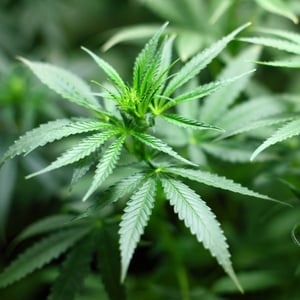
Marijuana (THC – tetrahydrocannabinol, Cannabis, Pot, Mary Jane)
With recent and ongoing changes in the legalization of this product, its availability in both the medical and recreational markets has increased. Thus, increasing exposure to pets.
Cannabis sativa and cannabis indica are members of the Cannabaceae family. Their effects on people are, for the most part, well-known. However, ingestion by pets these same effects result in toxicity.
Depending on the product ingested and whether it was combined with other products such as chocolate (as in a brownie), or highly concentrated (in an e-cigarette oil) the symptoms could vary from mild to severe.
Signs of Marijuana Toxicity in Cats
Although dogs are typically more likely to be affected due to their less discerning palette, cats are still known for chewing o live plants or dried products.
Symptoms of toxicity may include, an uncoordinated gait (ataxia), dilated pupils, drooling, vomiting, dribbling urine (typically seen in dogs more commonly), as well as a slowed heart rate (bradycardia), tremors, and rarely seizures.
Onset of Symptoms
Signs are typically seen within minutes of ingestion and may take up to 2 hours to develop depending on the product ingested.
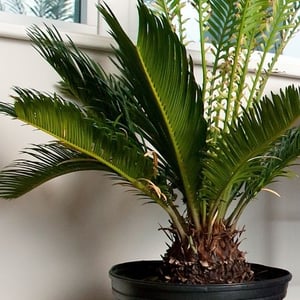
Sago Palms (Cardboard Palm, Cycads, Coontie Palm, Zamias)
Despite “palm” being part of their common name, sago palms are not actually palms. They're cycads, an ancient seed plant with a crown of large compound leaves and a stout trunk. A very common and potentially deadly plant found inside homes, on outside patios, and commonly used in landscaping.
Signs of Sago Toxicity in Cats
Vomiting, bloody stool, jaundice (yellowing of the skin and eyes), and increased thirst.
Onset of Symptoms
Signs typically happen within 15 minutes to 3–4 hours after eating. Aggressive treatment should be initiated ASAP. Even with aggressive treatment, the survival rate is approximately about 50%.
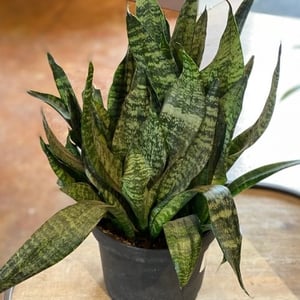
Snake Plant (Sansevieria, Mother-in-law’s Tongue)
This stemless evergreen perennial is a popular houseplant species. Its foliage can stretch anywhere from 2' to 4' tall. With leaves that stick straight up, its fleshy texture can be enticing to your feline, however, is only mildly toxic.
Signs of Snake Plant Toxicity in Cats
Nausea, vomiting, swelling of the mouth, lips or tongue, drooling, change in energy level, hiding, loss of appetite, and diarrhea.
Onset of Symptoms
Signs may take up to 4 hours to develop but could take as long as 8–12 hours.
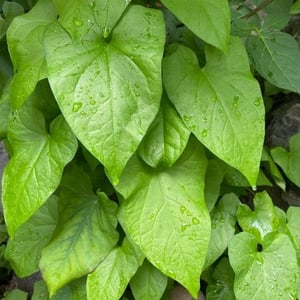
Sweetheart Ivy
A popular perennial known for its heart-shaped leaves, this plant will cascade down from its planter. So, if you do have one, hang it somewhere inaccessible to your cat. This is an invasive species in North Carolina and can be found in the Pacific Northwest as well. The leaves of Sweetheart Ivy are more toxic than the berries.
Signs of Sweetheart Ivy Toxicity in Cats
This plant's toxic compound (hederagenin) may result in excessive drooling, vomiting, abdominal discomfort, and diarrhea.
Onset of Symptoms
Signs may be seen within 4–8 hours of ingestion but may take up to 12 hours after ingestion to develop.
Myth Buster: Are Poinsettias Toxic for Pets?

Ironically, poinsettias, one of the more well-known holiday plant hazards for pets, may not be as hazardous to pets as once thought. Due to the low level of toxicity seen with poinsettia ingestion, medical intervention is rarely needed unless signs are severe or persistent.
Mild signs of Poinsettia toxicity in pets may include vomiting, drooling, and, rarely, diarrhea. The milky sap can irritate the skin, causing redness, swelling, and itchiness.
Repeated exposure can result in a higher level of toxicity or increased skin irritation.
Symptoms may be missed due to their mild nature, however, they may become apparent within 2–4 hours of ingestion but repeated exposure may be necessary for more obvious signs to become apparent.
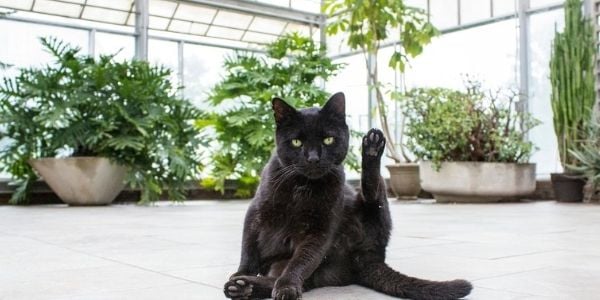
The full list of toxic plants is extensive for both indoor and outdoor plants. You can get the full list from the ASPCA's Animal Poison Control page of Toxic and Non-Toxic Plants. Hopefully, this article has helped inform you as you go to the nursery to choose your greenery, or even if your cat enjoys spending time outside.
Common Symptoms of Toxic Plant Poisoning in Cats May Include:
- Mental dullness, decreased interaction, or hiding
- Severe irritation or ulceration of the mouth, lips, and tongue: Signs include a cat pawing at their mouth, decreased appetite, gagging, drooling, or bad cat breath
- Difficulty swallowing
- Vomiting, gagging, or retching
- Stomach pain: Signs that your cat has stomach pain might include decreased appetite, low energy, hiding, vomiting, and a decrease in urination and bowel movements
- Diarrhea
- Excessive drooling
- Changes in urine: This could be a change in color or change in the amount of urine (could be more or less)
- Changes in thirst (could be increased or decreased)
- Loss of appetite
- Low energy
- Tremor, seizures
- Coma
If you're looking for great non-toxic plant alternatives, check out our Top 10 Indoor Plants Safe for Cats article!




